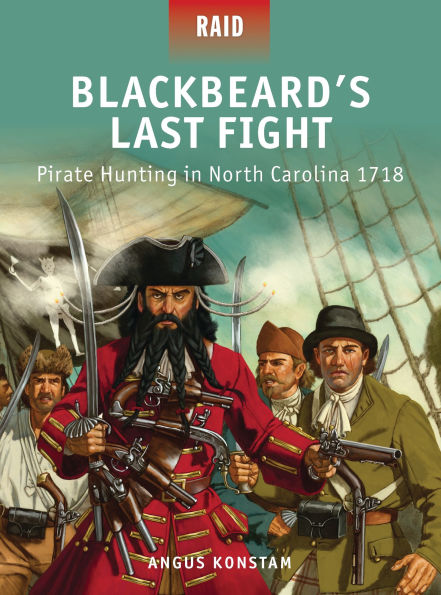He joined the pirates in New Providence (now Nassau) in the Bahamas, and by early 1717 he had become a pirate captain. From then on he caused havoc off the North American seaboard, in the West Indies and off Honduras, before appearing off Charleston, South Carolina in May 1718. He blockaded this major port for a week, an act that made Blackbeard the most notorious pirate of his day.
He then "downsized" - deliberately running his flagship aground near Beaufort, North Carolina, before sailing north in a small sloop to seek a pardon from the colony's governor, Charles Eden. For late June onwards, Blackbeard lived in the colony's tiny capital of Bath Town, and pretended to have turned his changed his ways. However, he also established a den on nearby Ocracoke Island in North Carolina's outer banks, and used this as a base for pirate forays into the waters of the Virginia and Delaware. He then used Bath Town as a clearing house for his plunder.
In the neighbouring colony of Virginia, Governor Alexander Spotswood decided to take action. Two British warships were anchored in Virginia's James River, and he and their captains began planning a raid - an attack designed to deal with Blackbeard once and all.
In November 1718 Lieutenant Maynard was sent south down the coast with two hired sloops, and orders to seek out and destroy Blackbeard's sloop, the Adventure. At the same time a land expedition was mounted, led by Captain Brandt of the Royal Navy. His men "invaded" North Carolina, and marched on Bath Town, hoping to corner the pirates and capture their stockpile of plunder.
On Friday 22nd November the sloops Ranger and Jane rounded Ocracoke Island, and attacked the Adventure. In the small but hard-fought action that followed Blackbeard's vessel was boarded, and the pirate captain was slain. While Maynard sailed home to Virginia with Blackbeard's severed head hanging from his bowsprit, Captain Brandt seized Bath Town, captured what pirates still remained at large, and then headed back in triumph to Williamsburg with his prisoners. Most of them would be hanged before the year was out. The attack on Blackbeard's lair was the largest anti-piracy operation of the "Golden Age of Piracy", and a textbook example of how to deal with the scourge of piracy.
He joined the pirates in New Providence (now Nassau) in the Bahamas, and by early 1717 he had become a pirate captain. From then on he caused havoc off the North American seaboard, in the West Indies and off Honduras, before appearing off Charleston, South Carolina in May 1718. He blockaded this major port for a week, an act that made Blackbeard the most notorious pirate of his day.
He then "downsized" - deliberately running his flagship aground near Beaufort, North Carolina, before sailing north in a small sloop to seek a pardon from the colony's governor, Charles Eden. For late June onwards, Blackbeard lived in the colony's tiny capital of Bath Town, and pretended to have turned his changed his ways. However, he also established a den on nearby Ocracoke Island in North Carolina's outer banks, and used this as a base for pirate forays into the waters of the Virginia and Delaware. He then used Bath Town as a clearing house for his plunder.
In the neighbouring colony of Virginia, Governor Alexander Spotswood decided to take action. Two British warships were anchored in Virginia's James River, and he and their captains began planning a raid - an attack designed to deal with Blackbeard once and all.
In November 1718 Lieutenant Maynard was sent south down the coast with two hired sloops, and orders to seek out and destroy Blackbeard's sloop, the Adventure. At the same time a land expedition was mounted, led by Captain Brandt of the Royal Navy. His men "invaded" North Carolina, and marched on Bath Town, hoping to corner the pirates and capture their stockpile of plunder.
On Friday 22nd November the sloops Ranger and Jane rounded Ocracoke Island, and attacked the Adventure. In the small but hard-fought action that followed Blackbeard's vessel was boarded, and the pirate captain was slain. While Maynard sailed home to Virginia with Blackbeard's severed head hanging from his bowsprit, Captain Brandt seized Bath Town, captured what pirates still remained at large, and then headed back in triumph to Williamsburg with his prisoners. Most of them would be hanged before the year was out. The attack on Blackbeard's lair was the largest anti-piracy operation of the "Golden Age of Piracy", and a textbook example of how to deal with the scourge of piracy.

Blackbeard's Last Fight: Pirate Hunting in North Carolina 1718
80
Blackbeard's Last Fight: Pirate Hunting in North Carolina 1718
80
Product Details
| ISBN-13: | 9781780961958 |
|---|---|
| Publisher: | Bloomsbury USA |
| Publication date: | 06/18/2013 |
| Series: | Raid , #37 |
| Pages: | 80 |
| Product dimensions: | 7.25(w) x 9.75(h) x 0.45(d) |
